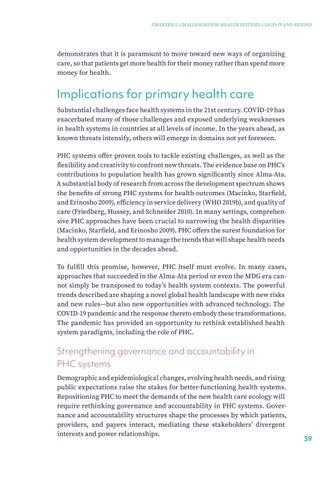CHAPTER 2: CHALLENGES FOR HEALTH SYSTEMS: COVID-19 AND BEYOND
demonstrates that it is paramount to move toward new ways of organizing care, so that patients get more health for their money rather than spend more money for health.
Implications for primary health care Substantial challenges face health systems in the 21st century. COVID-19 has exacerbated many of those challenges and exposed underlying weaknesses in health systems in countries at all levels of income. In the years ahead, as known threats intensify, others will emerge in domains not yet foreseen. PHC systems offer proven tools to tackle existing challenges, as well as the flexibility and creativity to confront new threats. The evidence base on PHC’s contributions to population health has grown significantly since Alma-Ata. A substantial body of research from across the development spectrum shows the benefits of strong PHC systems for health outcomes (Macinko, Starfield, and Erinosho 2009), efficiency in service delivery (WHO 2019b), and quality of care (Friedberg, Hussey, and Schneider 2010). In many settings, comprehensive PHC approaches have been crucial to narrowing the health disparities (Macinko, Starfield, and Erinosho 2009). PHC offers the surest foundation for health system development to manage the trends that will shape health needs and opportunities in the decades ahead. To fulfill this promise, however, PHC itself must evolve. In many cases, approaches that succeeded in the Alma-Ata period or even the MDG era cannot simply be transposed to today’s health system contexts. The powerful trends described are shaping a novel global health landscape with new risks and new rules—but also new opportunities with advanced technology. The COVID-19 pandemic and the response thereto embody these transformations. The pandemic has provided an opportunity to rethink established health system paradigms, including the role of PHC.
Strengthening governance and accountability in PHC systems Demographic and epidemiological changes, evolving health needs, and rising public expectations raise the stakes for better-functioning health systems. Repositioning PHC to meet the demands of the new health care ecology will require rethinking governance and accountability in PHC systems. Governance and accountability structures shape the processes by which patients, providers, and payers interact, mediating these stakeholders’ divergent interests and power relationships.
39


